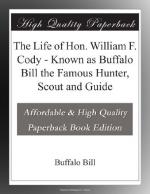As a matter of interest to the general reader, it may be well in this connection to give a brief description of a freight train. The wagons used in those days by Russell, Majors & Waddell were known as the “J. Murphy wagons,” made at St. Louis specially for the plains business. They were very large and were strongly built, being capable of carrying seven thousand pounds of freight each. The wagon-boxes were very commodious—being as large as the rooms of an ordinary house—and were covered with two heavy canvas sheets to protect the merchandise from the rain. These wagons were generally sent out from Leavenworth, each loaded with six thousand pounds of freight, and each drawn by several yokes of oxen in charge of one driver. A train consisted of twenty-five wagons, all in charge of one man, who was known as the wagon-master. The second man in command was the assistant wagon-master; then came the “extra hand,” next the night herder; and lastly, the cavallard driver, whose duty it was to drive the lame and loose cattle. There were thirty-one men all told in a train. The men did their own cooking, being divided into messes of seven. One man cooked, another brought wood and water, another stood guard, and so on, each having some duty to perform while getting meals. All were heavily armed with Colt’s pistols and Mississippi yagers, and every one always had his weapons handy so as to be prepared for any emergency.
The wagon-master, in the language of the plains, was called the “bull-wagon boss”; the teamsters were known as “bull-whackers”; and the whole train was denominated a “bull-outfit.” Everything at that time was called an “outfit.” The men of the plains were always full of droll humor and exciting stories of their own experiences, and many an hour I spent in listening to the recitals of thrilling adventures and hair-breadth escapes.
Russell, Majors & Waddell had in their employ two hundred and fifty trains, composed of 6,250 wagons, 75,000 oxen, and about eight thousand men; their business reaching to all the government frontier posts in the north and west, to which they transported supplies, and they also carried freight as far south as New Mexico.
[Illustration: A PRAIRIE SCHOONER.]
The trail to Salt Lake ran through Kansas to the northwest, crossing the Big Blue river, then over the Big and Little Sandy, coming into Nebraska near the Big Sandy. The next stream of any importance was the Little Blue, along which the trail ran for sixty miles; then crossed a range of sand-hills and struck the Platte river ten miles below Old Fort Kearney; thence the course lay up the South Platte to the old Ash Hollow Crossing, thence eighteen miles across to the North Platte—near the mouth of the Blue Water, where General Harney had his great battle in 1855 with the Sioux and Cheyenne Indians. From this point the North Platte was followed, passing Court House Rock, Chimney Bock and Scott’s Bluffs, and then on to Fort Laramie,




